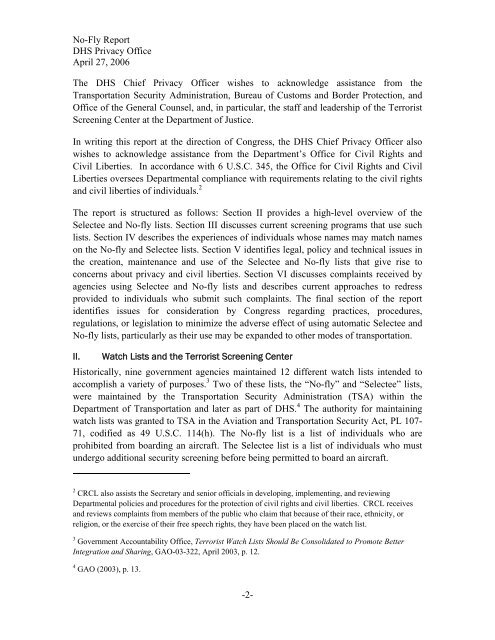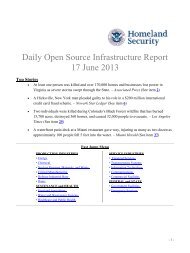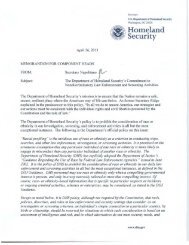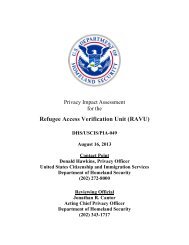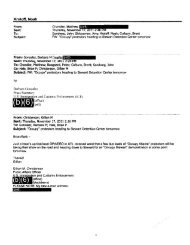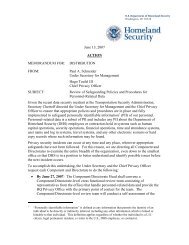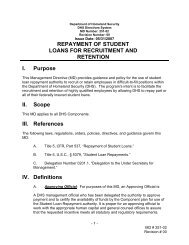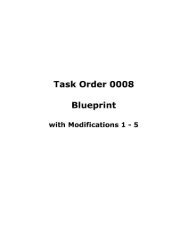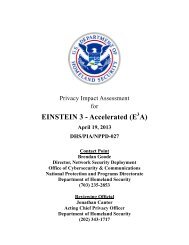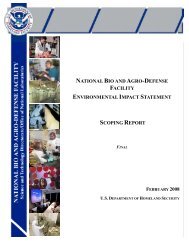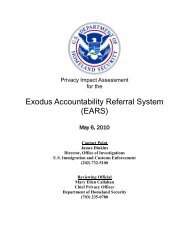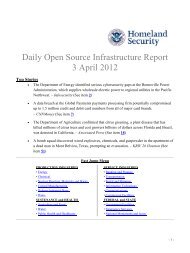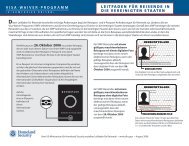Report: No Fly - Homeland Security
Report: No Fly - Homeland Security
Report: No Fly - Homeland Security
You also want an ePaper? Increase the reach of your titles
YUMPU automatically turns print PDFs into web optimized ePapers that Google loves.
<strong>No</strong>-<strong>Fly</strong> <strong>Report</strong><br />
DHS Privacy Office<br />
April 27, 2006<br />
The DHS Chief Privacy Officer wishes to acknowledge assistance from the<br />
Transportation <strong>Security</strong> Administration, Bureau of Customs and Border Protection, and<br />
Office of the General Counsel, and, in particular, the staff and leadership of the Terrorist<br />
Screening Center at the Department of Justice.<br />
In writing this report at the direction of Congress, the DHS Chief Privacy Officer also<br />
wishes to acknowledge assistance from the Department’s Office for Civil Rights and<br />
Civil Liberties. In accordance with 6 U.S.C. 345, the Office for Civil Rights and Civil<br />
Liberties oversees Departmental compliance with requirements relating to the civil rights<br />
and civil liberties of individuals. 2<br />
The report is structured as follows: Section II provides a high-level overview of the<br />
Selectee and <strong>No</strong>-fly lists. Section III discusses current screening programs that use such<br />
lists. Section IV describes the experiences of individuals whose names may match names<br />
on the <strong>No</strong>-fly and Selectee lists. Section V identifies legal, policy and technical issues in<br />
the creation, maintenance and use of the Selectee and <strong>No</strong>-fly lists that give rise to<br />
concerns about privacy and civil liberties. Section VI discusses complaints received by<br />
agencies using Selectee and <strong>No</strong>-fly lists and describes current approaches to redress<br />
provided to individuals who submit such complaints. The final section of the report<br />
identifies issues for consideration by Congress regarding practices, procedures,<br />
regulations, or legislation to minimize the adverse effect of using automatic Selectee and<br />
<strong>No</strong>-fly lists, particularly as their use may be expanded to other modes of transportation.<br />
II. Watch Lists and the Terrorist Screening Center<br />
Historically, nine government agencies maintained 12 different watch lists intended to<br />
accomplish a variety of purposes. 3 Two of these lists, the “<strong>No</strong>-fly” and “Selectee” lists,<br />
were maintained by the Transportation <strong>Security</strong> Administration (TSA) within the<br />
Department of Transportation and later as part of DHS. 4 The authority for maintaining<br />
watch lists was granted to TSA in the Aviation and Transportation <strong>Security</strong> Act, PL 107-<br />
71, codified as 49 U.S.C. 114(h). The <strong>No</strong>-fly list is a list of individuals who are<br />
prohibited from boarding an aircraft. The Selectee list is a list of individuals who must<br />
undergo additional security screening before being permitted to board an aircraft.<br />
2 CRCL also assists the Secretary and senior officials in developing, implementing, and reviewing<br />
Departmental policies and procedures for the protection of civil rights and civil liberties. CRCL receives<br />
and reviews complaints from members of the public who claim that because of their race, ethnicity, or<br />
religion, or the exercise of their free speech rights, they have been placed on the watch list.<br />
3<br />
Government Accountability Office, Terrorist Watch Lists Should Be Consolidated to Promote Better<br />
Integration and Sharing, GAO-03-322, April 2003, p. 12.<br />
4 GAO (2003), p. 13.<br />
-2-


